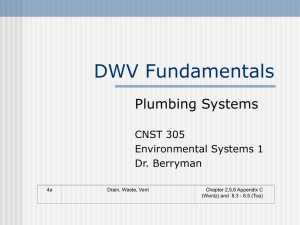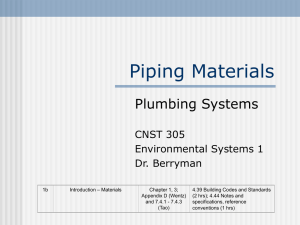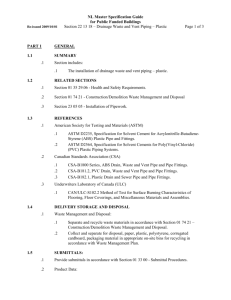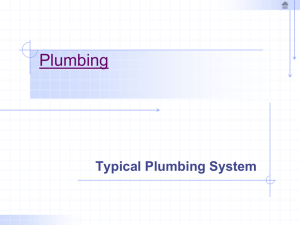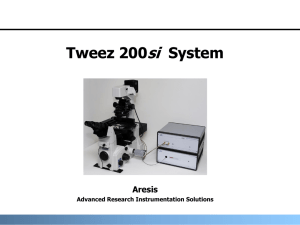Plumbing II: DWV Systems Installation Unit Plan Resource
advertisement
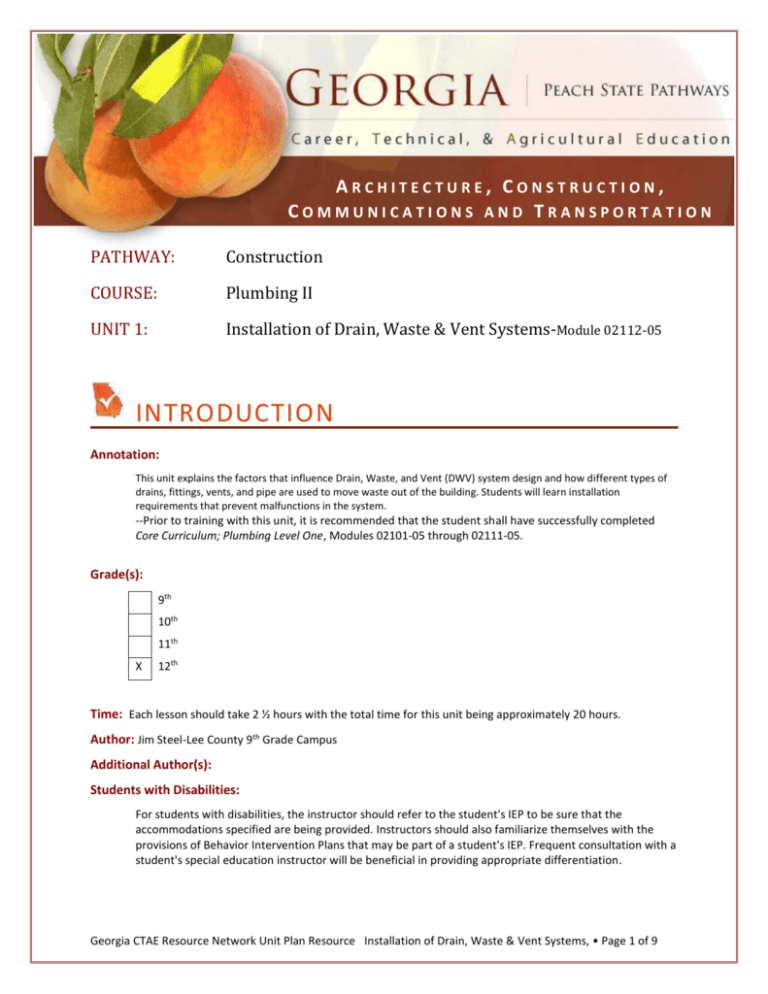
ARCHITECTURE, CONSTRUCTION, COMMUNICATIONS AND TRANSPORTATION PATHWAY: Construction COURSE: Plumbing II UNIT 1: Installation of Drain, Waste & Vent Systems-Module 02112-05 INTRODUCTION Annotation: This unit explains the factors that influence Drain, Waste, and Vent (DWV) system design and how different types of drains, fittings, vents, and pipe are used to move waste out of the building. Students will learn installation requirements that prevent malfunctions in the system. --Prior to training with this unit, it is recommended that the student shall have successfully completed Core Curriculum; Plumbing Level One, Modules 02101-05 through 02111-05. Grade(s): 9th 10th 11th X 12th Time: Each lesson should take 2 ½ hours with the total time for this unit being approximately 20 hours. Author: Jim Steel-Lee County 9th Grade Campus Additional Author(s): Students with Disabilities: For students with disabilities, the instructor should refer to the student's IEP to be sure that the accommodations specified are being provided. Instructors should also familiarize themselves with the provisions of Behavior Intervention Plans that may be part of a student's IEP. Frequent consultation with a student's special education instructor will be beneficial in providing appropriate differentiation. Georgia CTAE Resource Network Unit Plan Resource Installation of Drain, Waste & Vent Systems, • Page 1 of 9 FOCUS STANDARDS GPS Focus Standards: ACT-P2-1. Students will demonstrate knowledge of how to install drain, waste, and vent systems. a. Install plastic, steel, iron, and copper pipes and fittings used in DWV. GPS Academic Standards: MC1G1. Students will investigate properties of geometric figures in the coordinate plane. MC1P1. Students will solve problems (using appropriate technology). MC1P3. Students will communicate mathematically. MC1P4. Students will make connections among mathematical ideas and to other disciplines. MC2A2. Students will solve simple equations. SCSh5. Students will demonstrate the computation and estimation skills necessary for analyzing data and developing reasonable scientific explanations. SSCG18. The student will demonstrate knowledge of the powers of Georgia’s state and local governments. SSCG15. The student will explain the functions of the departments and agencies of the federal bureaucracy. National / Local Standards / Industry / ISTE: NCCER 02112-05 Introduction to drain, waste, and vent (DWV) systems UNDERSTANDINGS & GOALS Enduring Understandings: Students will understand that the goal of the plumber is to protect the health, safety, and comfort of the nation job by job. Codes vary from among jurisdictions. Because of variations in code, is important to consult the applicable code whenever regulations are in question. Referring to an incorrect set of codes can cause as much trouble as failing to reference codes altogether. It is important to obtain, review, and familiarize yourself with your local adopted code. Essential Questions: Why is it important to understand the history and the development of plumbing codes? How can failure to understand and follow established codes affect the health and welfare of people? Knowledge from this Unit: Upon completion of this unit, the student will be able to do the following: Explain how waste moves from a fixture through the drain system to the environment. Identify the major components of a drainage system and describe their functions. Identify the different types of traps and their components, explain the importance of traps, and identify the ways that traps can lose their seals. Georgia CTAE Resource Network Unit Plan Resource Installation of Drain, Waste & Vent Systems, • Page 2 of 9 Identify the various types of drain, waste, and vent (DWV) fittings and describe their applications. Identify significant code and health issues, violations, and consequences related to DWV systems. Skills from this Unit: Under supervision of the instructor, the student should be able to do the following: Sketch a simple DWV system, label its components, and size the pipe. ASSESSMENT(S) Assessment Method Type: X X Pre-test Objective assessment - multiple-choice, true- false, etc. _x_ Quizzes/Tests _x_ Unit test X X Group project Individual project Self-assessment - May include practice quizzes, games, simulations, checklists, etc. __ Self-check rubrics __ Self-check during writing/planning process __ Journal reflections on concepts, personal experiences and impact on one’s life __ Reflect on evaluations of work from teachers, business partners, and competition judges __ Academic prompts __ Practice quizzes/tests Subjective assessment/Informal observations __ Essay tests __ Observe students working with partners __ Observe students role playing Peer-assessment __ Peer editing & commentary of products/projects/presentations using rubrics __ Peer editing and/or critiquing Dialogue and Discussion __ Student/teacher conferences __ Partner and small group discussions __ Whole group discussions __ Interaction with/feedback from community members/speakers and business partners Constructed Responses __ Chart good reading/writing/listening/speaking habits __ Application of skills to real-life situations/scenarios X Post-test Assessment(s) Title: Each section has a quiz over the material covered. At the end of the module, there is a trade term quiz to be covered. Performance Tests and Written test Georgia CTAE Resource Network Unit Plan Resource Installation of Drain, Waste & Vent Systems, • Page 3 of 9 Assessment(s) Description/Directions: Section quiz: Have students complete the section quizzes Trade Term Quiz: have students complete the trade term quiz Performance tests and written tests are found in the Testing Booklet Attachments for Assessment(s): LEARNING EXPERIENCES Sequence of Instruction Safety considerations: Ensure that students are equipped with appropriate personal protective equipment, and they are properly instructed on its use. Stress the specific hazards of working with DWV systems, such as exposure to toxic gases, and explain the related necessary safety precautions. Lesson 1: Introduction to DWV Systems, Fixtures, Drains, and Traps 1. Identify the Standards. Standards should be posted in the classroom for each lesson. 2. Review Essential Questions. 3. Identify and review the unit vocabulary. Many of the terms used in this lesson were introduced in the Core Curriculum module and previous lessons. Additional terms for this are: DWV system building sewer siphonage back pressure backpressure backflow P-traps Cleanout interceptors s-traps weirs crown weir trap weir double trapping 4. Lesson content: Introduction to DWV Systems, Fixtures, Drains, and Traps A. DWV systems: Review and discuss the basics of drainage system design. Review the three components of sanitary drainage systems. Discuss and review the possibilities for plumbers and municipalities installing and maintaining DWV systems. Using figure 2 on page 12.4, review the major components of a DWV system. B. Fixture Drains: using figure 3 on page 12.4, review of basic examples of fixture drains. C. Types of Traps: Discuss and explain how traps prevent gases from leaking into a building without affecting the flow of sewage or wastewater. Discuss the different types of traps to include: P-Trap Two-piece Trap One-piece Trap S- Trap Explain the role of a fixture trap in DWV system. Discuss the problems that can be prevented by proper working fixture trap. Bring in a P-trap and demonstrate how to attach a P-trap to a fixture. Discuss the various types of interceptors and their specific applications. Explain why the use of S- Traps is prohibited. Discuss the problems caused by double trapping. Georgia CTAE Resource Network Unit Plan Resource Installation of Drain, Waste & Vent Systems, • Page 4 of 9 D. Parts of Traps: using figure 8 on page 12.6, review the parts of a trap and explain how they operate. Inlet Crown Weir (Trap Weir) Top Dip Fixture Drains (also called a Trap Arm) Bottom Dip 5. Review: Distribute copies of figure 8 with the callouts covered. Ask students to identify the components of a trap, and write a brief explanation of how they operate. Lesson 2: Installation Requirements 1. Identify the Standards. Standards should be posted in the classroom for each lesson. 2. Review Essential Questions. 3. Identify and review the unit vocabulary. Many of the terms used in this lesson were introduced in the Core Curriculum module and previous lessons. Additional terms for this are: Fall hydraulic gradient stack evaporation capillary attraction 4. Lesson content: Installation Requirements A. Trap Installation Requirements: Discuss how proper installation will depend on the local code and what it allows. Using figure 9 on page 12.7, explain the relationship between vertical distance and horizontal distance in determining trap installation requirements. Using table 1 on page 12.7, have students determine the appropriate vertical and horizontal distances using trap installation criteria. Discuss the concept of total drop (or fall). Using a P-trap in two pieces, demonstrate how the J-bend piece joins the fixture in the trap arm (outlet end) joins the horizontal drain. Discuss why traps should be installed for all fixtures that do not have built-in traps. B. Why a Trap Loses Its Seal: Using figure can on page 12.8, discuss and review the operation of a properly functioning trap. Review the primary causes of a trap losing seal: Siphonage: Explain what causes siphonage and what how to prevent it. Aspiration: Discuss the concept of aspiration. Discuss the importance of testing for gas before working in or around areas where toxic gas may be present. Review why S-Traps are no longer used. Momentum: Discuss the effect of vertical distance on momentum. Review applicable codes to determine correct distance. Oscillation: Discuss the concept of oscillation and how oscillation, although rare, can weaken a trap. Back Pressure: Using Figure 12 on page 12.10, review the proper sizing requirements that may be necessary to prevent back pressure. Evaporation: Explain when to use extra-deep traps and trap primers and how they may prevent evaporation. Capillary Attraction: Discuss the cause of capillary attraction and explain how to solve it. Cracks: Discuss the common causes of cracks in traps. 1. Review the mnemonic device: SAMOBECC S: Siphonage A: Asperiation Georgia CTAE Resource Network Unit Plan Resource Installation of Drain, Waste & Vent Systems, • Page 5 of 9 M: Momentum O: Oscillation B: Back Pressure E: Evaporation C: Capillary Attraction C: Crack Lesson 3: Vents, Drains, and Fittings 1. Identify the Standards. Standards are posted in the classroom for each lesson. 2. Review Essential Questions. 3. Identify and review the unit vocabulary. Many of the terms used in this lesson were introduced in the Core Curriculum module and previous lessons. Additional terms for this are: Drainage fittings sanitary fittings run side inlets short sweep ¼ bends long sweep ¼ bends Double ¼ bends adapters vent ells vent tees pipe scale test tees sanitary wyes sanitary upright wyes Vent branches inverted wyes sanitary combination sanitary increasers 4. Lesson content: Vents, Drains, and Fittings A. Vents: Using figure 14 on page 12.12, explain how proper venting can prevent back pressure and siphonage. Using local code, have students locate a table that displays maximum distance is allowed between the pipe and the vent. Review with the students the information found so they understand how to interpret the data and determine the appropriate pipe fall and diameter. B. Sizing Drain: discuss the effect of rainfall on storm water drainage and expected water use on building drainage. Discuss considerations for sizing vents. 1. Fittings and Their Applications: Bring in several drainage fittings made of a variety of materials. 2. DWV materials: Demonstrate how like fittings made from different materials have the same use within the DWV piping system. Provide examples of special applications were lead fittings are used (such as piping that contained chemical waste). Explain that fittings of the same design had the same name, regardless of the fitting material used to make it. 3. General DWV fittings requirements: Using figure 16 on pages 12.14, explain how a sweeping design allows for his smooth flow of material. Discuss the proper direction of hub pipe fittings. 4. DWV fittings: Ask students to explain when a sanitary fitting may be joined to a system without reducers. a) Bends: Using figure 17 on page 12.14, review different sizes of bends, and explain how they are used to change the direction of a run of pipe. Discuss bends and how bends are placed in a plumbing system. Discuss the formula for determining the number of degrees a given bend turns. Using the example in the text, have students calculate the bend angle of a ¼ bend. Formula: 1. Multiple the bend type ¼ by 360 (¼ * 360=.025) 2. Multiply that answer by 360 to determine the number of degrees in a ¼ bend (0.025 * 360= 90°) Review the three patterns in which ¼ bends are available. Georgia CTAE Resource Network Unit Plan Resource Installation of Drain, Waste & Vent Systems, • Page 6 of 9 Explain how to determine whether inlets are right or left inlets. Explain why short and long sweep ¼ bends are required by various codes. Explain why double ¼ bends are used to collect and combine flow from two opposite runs, Explain why vent ells are only permitted in vent lines. See figures 20 & 21 on page 12.16. b) Adapters: Explain how adapters are used to join pipes of different materials. c) Cleanouts: Explain how cleanout fittings are used to remove blockage and prevent leakage. d) Tees: Review the basic sanitary branch fittings, and explain how they are used to connect branch lines entering systems from opposite directions. Discuss the role of sanitary tees. Discuss and emphasize why vent tees are prohibited for use in drainage systems. Using figure 27 on page 12.18, explain when and how test tees are used as test locations. e) Wyes: Review the various types of wyes and explain how they connect to the vent. Using figure 33 on page 12.19, discuss the benefit of using combination fittings to reduce the number of fittings, f) Miscellaneous fittings: Discuss the role of sanitary increasers in a DWV system. Explain how offsets are used to change the path of the pipe. Lesson 4: DWV System Design 1. Identify the Standards. Standards should be posted in the classroom for each lesson. 2. Review Essential Questions. 3. Identify and review the unit vocabulary. Many of the terms used in this lesson were introduced in the Core Curriculum module and previous lessons. Additional terms for this are: Grade slope velocity branch interval elevation sludge 4. Lesson content: DWV System Design A. Grade: Using figure 36 on page 12.21, discuss the concepts of grade and slope. Explain how grade affects the velocity of liquid waste flowing through the piping. Discuss the consequences of too much grade and too little grade being used. Using a torpedo level, demonstrate how the level is used to measure grade for small runs of pipe. B. Building Drain: Discuss the roles of a building drain, stack and branch interval in a DWV system. Explain how these components work together. C. Building Sewer: Explain where building and house sewers are located and discuss the materials from which sewers are commonly made. Explain the intervals at which manholes must be located. Explain who is responsible for installing, maintaining, and controlling public and municipal servers. D. Waste Treatment: Using figure 38 on page 12.23, review the components of a municipal sewage treatment plant. Review the flow of waste in private waste disposal systems. Review the components of a conventional septic system. Using plans for municipal waste treatment systems and private waste disposal systems, explain to students the plans and what is shown in the plans. E. Code and Health Issues Georgia CTAE Resource Network Unit Plan Resource Installation of Drain, Waste & Vent Systems, • Page 7 of 9 5. Review A. Review B. Module Examination 1. Trainees must score 70% or higher to receive recognition from NCCER. 2. Record the testing results on Craft Training Report Form 200 and submit the results to the Training Program Sponsor. C. Performance Testing 1. Trainees must perform each task to the satisfaction of the instructor to receive recognition from NCCER. If applicable, proficiency noted during laboratory exercises can be used to satisfy the Performance Testing requirements. 2. Record the testing results on Craft Training Report Form 200, and submit the results to the Training Program Sponsor. Attachments for Learning Experiences:. Notes & Reflections: CULMINATING PERFORMANCE TASK Culminating Unit Performance Task Title: Culminating Unit Performance Task Description/Directions/Differentiated Instruction: Attachments for Culminating Performance Task: UNIT RESOUR CES Web Resources: Attachment(s): Materials & Equipment: Classroom Use Transparencies Markers/chalk Blank acetate sheets Transparency pens Pencils and scratch paper Overhead projector and screen Whiteboard/chalkboard Copies of your local code Georgia CTAE Resource Network Unit Plan Resource Installation of Drain, Waste & Vent Systems, • Page 8 of 9 DWV system design drawings Copies of Figure 8 with the callouts covered Plans for a municipal waste treatment plant Plans for a private waste disposal system Testing Module Examinations Performance Profile Sheets Shop Use Appropriate personal protective equipment P-traps Drainage fittings made from a variety of materials DWV fittings, including: Bends Adapters Cleanouts Tees Wyes Increasers Offsets Torpedo level What 21st Century Technology was used in this unit? Slide Show Software Graphing Software Audio File(s) Interactive Whiteboard Calculator Graphic Organizer Student Response System Desktop Publishing Image File(s) Web Design Software Blog Video Animation Software Wiki Electronic Game or Puzzle Maker Email Website Georgia CTAE Resource Network Unit Plan Resource Installation of Drain, Waste & Vent Systems, • Page 9 of 9
